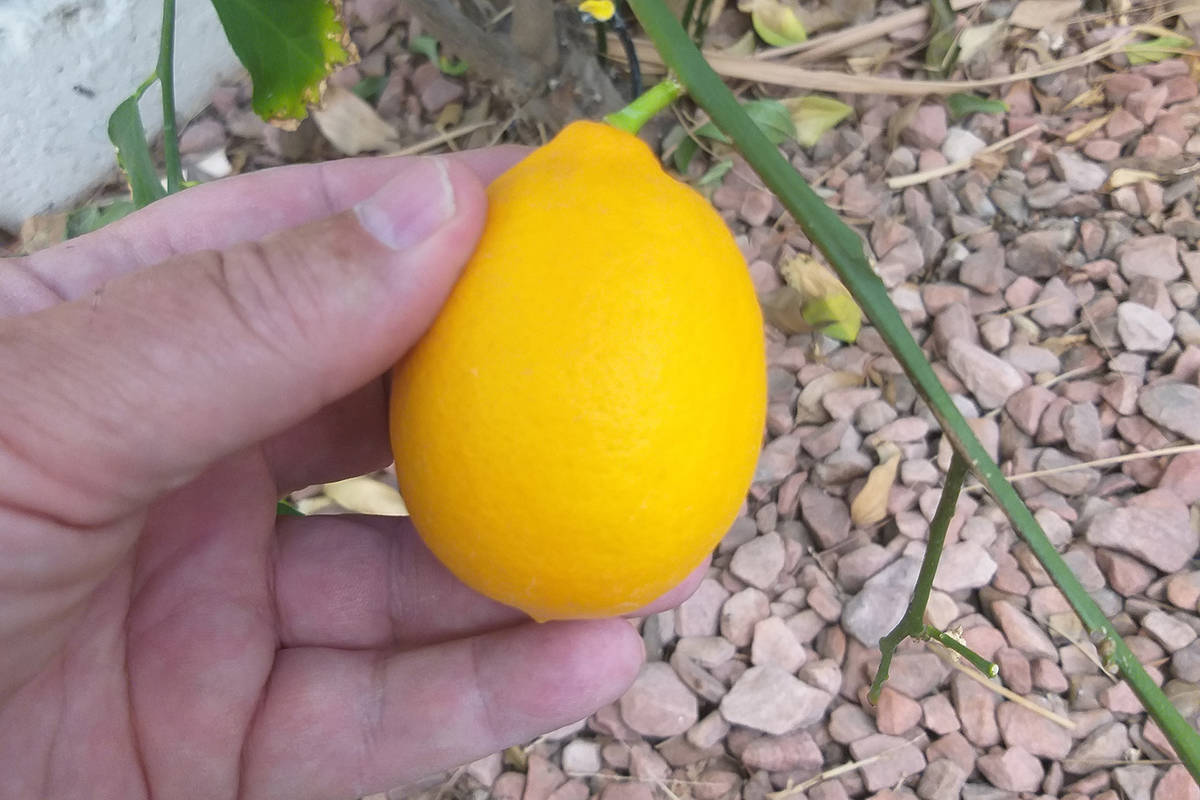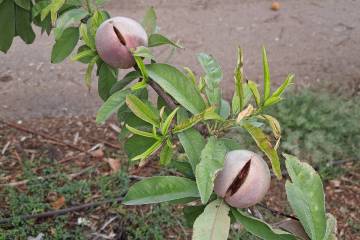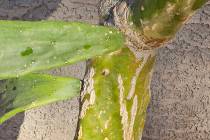Winter freeze can affect citrus fruit production
Why doesn’t my Meyer lemon tree produce any fruit? I was reminded of this question when I estimated the fruit production this year in a Las Vegas orchard.
I use a particular variety of pluot called Flavor Supreme as an indicator tree for predicting the probable fruit load that year. I saw no fruit developing and I saw no remnants of flowers on these trees. I knew there was a late freeze that came through that orchard during the spring, probably two or three weeks ago.
How did I know all that and how do I relate it back to Meyer lemon? First of all, recognize it only takes a 1- or 2-degree difference in temperature between having a tree loaded with fruit versus having a tree with not much fruit. If this temperature difference comes along two or three times during the spring when it’s trying to flower, then there is no fruit produced that year.
The most tender part of any fruit tree affected by freezing temperatures is its flowers. When flowers are open, that’s when it is most sensitive to freezing temperatures. The tree itself is usually fine but not the flowers.
If a very light freeze occurs in the spring only once when the tree is flowering, then fruit production is reduced. If a light freeze happens two or three times, maybe a week apart during the spring, then the fruit is probably eliminated for that year. However, if there is a single hard freeze (4 or 5 degrees below freezing or more) as flower buds are awake, then most likely all fruit will be eliminated for that year.
Flowers are killed by freezing temperatures depending on their stage of development. Flower buds during the dead of winter are very tolerant to freezing temperatures. But in the spring, when the plant begins to wake up from its winter sleep, they become more and more sensitive to freezing temperatures as they approach opening.
Open flowers are the most sensitive to freezing temperatures; 1 degree below freezing for a very short time kills the single chance it has for fruit. Once a flower dies, it cannot produce fruit.
If the flowering time of a fruit tree lasts three weeks, then it has a better chance to produce fruit as more flowers continue to open. If only 5 percent of the flowers are needed to produce a full load of fruit and all the flowers are dead, there is no fruit for that year.
Q: I’ve had a dwarf Minneola tangelo tree for about four years that gets morning sun, but I’ve gotten fruit off it only once. I’ve had an orange tree for about a year and a half that gets full sun; it had blossoms, but they all fell off before the heat of summer even began. I planted a pomegranate tree in full sun this past Mother’s Day. When I bought it, it had blooms on it; they also all fell off. I just want some fruit.
A: There are several different issues with your fruit trees. The Minneola tangelo flowers only once in January and February. The same will be true of most sweet oranges.
If there are freezing temperatures during this time at your landscape locale, then you may get little to no fruit whenever this happens. When your landscape gets winters with no freezing temperatures, then each flower will produce fruit.
It only takes a couple of degrees below freezing for a very short time to eliminate the flower and fruit. Multiple freezes during the spring result in total fruit loss. You may see fruit from these trees in the future, but it depends on the occurrence of spring freezing temperatures.
Be patient growing most citrus here. Citrus is more productive when there are no winter or spring freezing temperatures such as in Yuma, Arizona. Periodically we get winter freezing temperatures that can outright kill different types of citrus trees.
The only reliable citrus for producing fruit in our climate is the so-called kumquat. This is because it is very cold hardy and flowers all through the year.
Loss of pomegranate fruit is a different story. Pomegranate flowers through most of the year because the flowers are produced on current-season wood — new growth and not last year’s growth. Some pomegranate varieties are more precocious than others and you will see fruit the first year they are planted. Other varieties produce fruit in the second or third year after they are in the ground.
Just be patient and they will produce fruit.
Q: I just planted Lisbon and Meyer lemon trees in full sun. Do I need to put shade cloth over them in the summer? I put shade cloth over my raised bed vegetable garden. They are planted along a northeast-facing wall and not surrounded by rock.
A: It’s a good location for fruit trees, but I’m not sure how your citrus will perform in your landscape locale. It’s touch and go in our climate. Much of their performance depends on the winter and spring temperatures of your landscape location.
If temperatures are very low during the winter, Lisbon and Meyer trees might both get killed. Meyer lemon is more cold hardy, but in a very cold location or during a very cold winter, it can be damaged or worse. If there are spring freezing temperatures, you might see less or no fruit produced on one or both trees.
Lisbon is a normal lemon tree; Meyer is not. Meyer lemon fruit tastes like a lemon but is actually a citrus hybrid with sour fruit. Lisbon is 5 or 6 degrees more tender to winter freezing temperatures than Meyer lemon so it may need winter protection in your landscape locale.
Citrus doesn’t need shade protecting it from our desert sun. Citrus grows in full sun in the Yuma area, so it doesn’t need shade cloth here either.
However, the first year after planting it might be a little shocked from its transfer from coastal California nursery to the harsher Mojave Desert so it may develop some leaf yellowing or leaf drop the first year. Give it a chance to acclimate to this desert area if the soil is improved at planting.
Q: A horticulturalist suggested putting my dwarf citrus trees in the biggest pot I have room for or can afford, and they will be happiest there. A person at a local nursery said to not move a tree from a small pot to a much larger pot and suggested the new pot be no more than 2 inches bigger in diameter than the small pot. The two questions seem to be in conflict. What do you think?
A: Both answers are acceptable, and pot size is not an issue as long as it is big enough. What is more important is the maintenance needed every few years for plants growing in containers.
The soil in the container gets worn out, and the roots need to be trimmed. Perhaps think about these containers like an aquarium; every few years, plants in containers need to be removed, fresh soil added, the roots trimmed and the plant repotted. This maintenance practice reinvigorates the plant and helps it live longer with fewer problems.
When selecting citrus trees for containers, make sure the tree is a dwarf or smaller in size. Smaller citrus like lime trees, calamondin and kumquat, although variable in how much cold they can tolerate, are naturally small in stature.
Oranges, lemons and larger citrus on dwarfing rootstock can also work but may be difficult to find. Look for the word “dwarf” on the label.
Also important is the transfer of heat from the sunny side of the container to the roots. Temperatures in the summer can be 170 degrees on the exposed side of the container.
Consider growing container plants inside another container so the inside container is protected from direct sun by a fancy decorative exterior container. The shade from the exterior container prevents the sun from heating up the interior container.
Q: Because of the winter cold weather, I move my citrus trees growing in containers into my garage, where it never gets below 40 degrees. I added three fluorescent light fixtures with grow lux bulbs per light fixture and they are hanging a few inches above the trees. Will this be sufficient light to keep the trees from being starved for light?
A: Although it’s less intense than outdoor sunlight, this will work. I’m guessing you keep these citrus trees in your garage all winter long. But I’m wondering if you even need all that.
Winter freezing temperatures low enough to kill flowers normally start around mid-December. Usually, by mid-February, these temperatures are over.
Although rare, sometimes we never experience freezing temperatures anywhere in the valley. Infrequently these temperatures are patchy and can start in mid-November (as they did in 2020) and can stretch into mid-March (as they did in 2021).
Do you see why I recommend putting a recording thermometer in your landscape? I also recommend downloading a weather app on your phone for predicting upcoming freezes.
Different landscapes experience different temperatures. Oftentimes these different landscapes follow different weather patterns. These weather patterns determine your level of success in our climate.
It would be much simpler for growing citrus if our climate was colder or warmer. But it’s not.
I’m also wondering if your citrus even needs the extra light. If temperatures are cold in your garage, the entire plant goes into hibernation and there is little need for light. For many plants, this magic temperature is around 40 to 45 degrees. Also, the darkness inside the garage can delay flowering.
Because the intensity of light is so low, I would leave these lights on for 16 to 18 hours every day. Long-term low light accumulation can sometimes substitute for short-term high light intensity (think sunlight). Because of these long light intervals, you might see earlier flowering in these trees.
Bob Morris is a horticulture expert and professor emeritus of UNLV. Visit his blog at xtremehorticulture.blogspot.com. Send questions to Extremehort@aol.com.





























